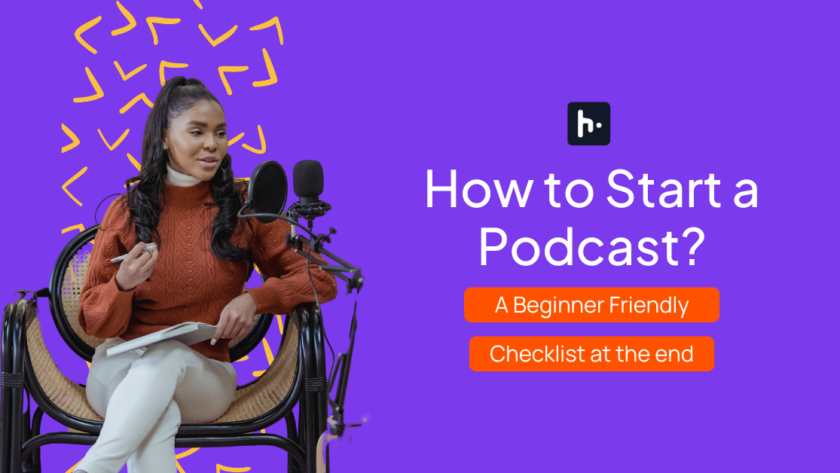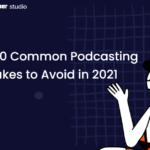To start a podcast all you need is:
- A solid idea
- Knowledge of how to turn that idea into bingeable content
- Some basic equipment
- A hosting platform
- A plan on how to keep producing episodes consistently
In this blog, we’ve put together a simple yet comprehensive guide on how to start a podcast. What’s more? A handy checklist right at the end to ensure a successful launch of your podcast.
So, grab your favorite cup of coffee, a pen, a notebook, and let’s launch your podcast.
Table of Contents
What is A Podcast – Simplified?
Podcasts are usually long form video or audio content which follows a common theme (aka niche) to either educate, entertain or inspire the audience.
If you want to share something with the world that not only grabs attention but keeps it, podcasting is the way to go. Podcasts began as audio-only but have now expanded to video also.
If you want to dive deeper into what is a podcast, we have a comprehensive blog on the same, feel free to check it out.
If you want to start your podcast, the first step is the pre-launch of your podcast.
How do you start a podcast? Step-by-step guide
Pre-Launch: Where the Magic Begins
Many think that the first step to how to start a podcast is recording an episode and shooting it but that’s not the case. The pre-launch phase is where you decide what your podcast will be about. And how to produce your podcast.
This pivotal phase can be divided into two key aspects: the creative and the technical. Let’s tackle the former first.
Creative – Embracing Your Creative Side
The creative side of podcasting can be a bit daunting for many. While others thrive in this arena. It’s an area that sparks both excitement and anxiety. But try to have fun with it. Because if you want to keep creating your podcast for a long time, injecting some fun at each stage helps a lot.
Podcast Topic Dilemma
Feeling stuck? Don’t know which topic to choose? Fret not, here are four tips select a topic:
- Passion Over Popularity: Opt for a topic you’re passionate about, rather than what’s trending because authentic interest always outshines fierce competition.
- Talkability Test: Your topic should be something you want to endlessly talk about.
- Embrace the Niche: Interested in a very generic topic? Can you identify a unique aspect unexplored before? If yes, consider it. Why? Targeting a smaller, passionate audience within a broader subject area can give you a highly engaged and loyal audience.
- Seasonal Strategy: Is your topic a seasonal one? Maintain consistency even during the off-season. Why? Many podcasts tend to fade during these times, offering you an opportunity to shine.
Need some inspiration? Consider these engaging topics for your podcast journey:
- True Crime
- Comedy
- Self-Improvement
- Technology
- Interviews
- Health and Wellness
- Business and Entrepreneurship
- Pop Culture Commentary
So, whether you’re drawn to solving mysteries, making people laugh, or helping others become the best versions of themselves, there’s a podcast topic waiting for your unique perspective.
If these topics are not your cup of tea, we have 105 Podcast Topics Ideas to choose from, check it out.
Content Research
Let’s talk about content! Once you pick a topic, how do you know what’s going to work and what’s not? And what do you actually talk about in each episode? Here’s a four step process you can follow to create your episode ideas.
Step 1: Competitor Research
What are your fellow podcasters talking about? And are there gaps? And if there are no gaps, what do you do? Your competitors’ research sheds light on all of these questions and helps you plan episodes that are better than what’s already out there.
To kickstart your competitor analysis, use this Google Sheet to uncover hidden treasures:
- Top Podcasts in Your Niche
- Hidden Gem Podcasts with Incredible Content
- Non-Podcast Yet Popular Gems
- Sought-After Topics
- Key Dates in Your Niche
- Notable Events in Your Niche
- Influential Personalities in Your Niche
As you compile the information, you’ll start noticing trends. Keep track of your insights, including keywords, trending themes, hot topics, popular hashtags, content approaches that worked, and topics that have been overdone under “Insights From Primary Research” for each topic.
Step 2: Unique Ingredients
Now, let’s try to come up with unique episode ideas. Engage with your family and friends to uncover their burning questions related to your niche.
If, for example, you’re exploring the world of cryptocurrency, ask them what puzzles them. If you find a question that’s not been answered by anybody, consider it a topic you should make an episode about. It’s your ticket to crafting content that truly stands out.
Step 3: Find more topic ideas
If you still feel you don’t have enough episode ideas, delve into these websites to find more:
- Trends24
- Google Trends
- Answer The Public
- Learn-Anything.xyz
- Google Question Hub
- AlsoAsked.com
- QuestionDB
- Quora
Step 4: Categorize your ideas
Now that you have enough ideas, it’s time to mix your content potion. Divide your episodes into three categories:
- Evergreen Content (timeless classics)
- Trending Content (buzz-worthy gems)
- Answer-Based Content (solving those burning questions)
Create a schedule for when you’re going to record and publish these episodes. Stick to your schedule (we’ll discuss this later, don’t worry), and voilà! You’ve conjured an organized and powerful content strategy that will keep your listeners coming back for more.
Finding Your Podcast Format
All podcasts can be divided based on the format they follow. Here are the common formats, and how they’re different from each other.
- The Solo Podcast
A solo podcast is a one-person show. Imagine yourself at the centre of your content, and sharing your knowledge with your audience. It’s perfect for individuals with expertise to share.
- The Interview Show
The interview show works best when the host thrives on conversations. Instead of shouldering the entire responsibility for an engaging episode, you bring in a new guest each week. This allows for a diverse array of topics and perspectives.
- The Panel Show
Picture a host and a rotating cast of guests where each offers fresh outlooks and perspectives. The panel show is a step up from the interview show and can have multiple hosts too. With so many hosts and guests, it can become quite entertaining as well as give you authentic and natural moments that your audience may enjoy.
- Conversational/Co-hosted Podcast
In this format, you have more than one host that remains constant throughout the show. Unlike the interview and panel show, where guests keep changing, here the show hinges on the hosts consistently having engaging discussions.
This format has the advantage of not dealing with the difficulty of managing various guests’ availability and schedule. Instead, it is just the hosts’ availability that you’ll have to manage.
- Non-Fictional Storytelling
This format unfolds captivating, real-life stories. It can have one host or may have multiple voice actors acting various parts of the stories. Just think of podcasts like “Serial” or “The Teacher’s Pet.” This format has a lot of advantages like being bingeable since people want to know what happens next.
- Fiction Storytelling
Want to tell your own stories? Fiction storytelling format will suit you better. A genre where this format excels is horror. You may also experiment with different genres and see which one suits you.
- Repurposed Content
Are you a content creator? Why not repurpose your old content? Breathe life into your old content by making small tweaks and converting it into a podcast. This way you increase the reach of your content by being on multiple platforms.
- Hybrid
You can also mix and match formats until you find a great fit. The choice is yours, and it’s as diverse as your imagination.
Finding the Perfect Podcast Name
What should you name your podcast? Maybe you already have a bunch of names but are unsure about which one to pick. This is completely normal. Here are top tips to help you narrow it down:
Keep it clear:
Simplicity is your best friend here. A podcast name that’s easy to remember and short is the one that will stick in your audience’s mind.
Avoid Alphabet Soup:
Acronyms may sound fun but are bad for audience recall. It might be tempting to shorten a big name to an acronym, but try to avoid it.
Check Availability:
If you have narrowed down that list, check if somebody has a podcast with that name or not. Is the domain available? Is it a username available on social media channels? If yes, then maybe tweak it a bit. Pre production and planning’s main aim is to avoid pitfalls like these when you’re already 10 episodes deep.
Ask for Feedback:
Ask your friends and family about the names you’ve narrowed down. Sometimes, a fresh perspective can lead to the perfect name.
For some name inspiration, we have a blog on 200+ ideas for podcast names and a much more detailed guide on how to choose a podcast name.
Crafting a Captivating Podcast Description
What do we do when we come across a podcast? We read the description before we listen to an episode to see if it is something up our alley.
A podcast description is crucial to attract your target audience. Here’s a brief guide on writing one:
1. Start with a hook that catches your audience’s attention.
2. Introduce your Podcast with one or two brief sentences.
3. Tell what’s your podcast’s main theme and how it is different from other podcasts in your niche.
4. Do you have unique selling points? Perhaps it is your guests line up or a twist on something commonly known? Mention it here to create even more interest.
5. Be a little tease by telling your audience what you’ve planned in the upcoming episodes.
6. If you won’t tell your audience to subscribe and share, guess what? They won’t. So when you’re wrapping it all up, ask them to subscribe and share. If they enjoy your content, they’ll share it when you ask them to.
7. Last but not the least, optimize your podcast description for search engines. If you have relevant keywords, include them in the description to enhance discoverability in search results.
Creating Eye-Catching Podcast Cover Art
Your cover art is the first point of contact with your listeners. It will inform them what your podcast is and what it is about.
- We recommend you keep it simple yet eye-catching.
- Keep the name of your podcast bold and clear. Focus on the font & size of the ‘podcast name’. Remember to keep the background complementary to the font style so that it looks good even in the thumbnail.
- Ensure the cover art is of high resolution.
- Always remember to create your podcast cover art in a 1:1 ratio, a square and save it in a JPG or PNG format.
- If you wish to start designing your cover art, then here is a video tutorial on how you can create using our in-built design tool.
- You can check out our blog on some additional designing tips for your cover art.
You can also check out our detailed guide on creating a catchy podcast cover art.
Scripting vs. Winging It
To write a script or wing it, that’s the question. See, when you’re thinking of how to start a podcast, scripting is an aspect that might stump you. But, it totally depends on the format you choose.
For instance, if you choose the interview format, a script is redundant since the episode’s content depends on the conversation with the guest. You can prepare some talking points beforehand.
If it is a solo podcast, having a script is useful. In the first episode just focus on introducing your podcast, yourself and what is in it for the listeners.
Focus on authenticity and delivering content concisely to keep it engaging. Whether that requires a script or not is totally up to you. You can also use a podcast outline to support you, so that you’re not going in circles but also gives you the freedom to speak naturally (and passionately).
Structuring Your Podcast for Success
There are many different structures your episode can take, but a basic structure you can follow is intro – body – outro.
Intro
A short and simple description of you as the host, the podcast and/or episode, giving listeners an idea of who you are and what you will discuss in the episode.
Body
The main portion of your podcast. This is where you share your story, insights, and any research you did for the chosen topic of the episode. Keep it structured and easy to follow along for your audience.
Outro
A short summary of the episode, sometimes with a short preview of or promo of the next episode. You can also precede this with CTAs like subscribe to the podcast, leave reviews, sign up for the newsletter, etc.
Background music
Many podcasters choose to have background music during at least the intro and outro sections; a great source for this music is YouTube’s Audio Library – they even have sound effects
Duration
Podcast episodes actually range from being 2-120 minutes long! When starting a podcast, aim for not more than 15 minutes and go from there. You may find that you have lots more to say, or not so much. In that case, experiment with various episode duration and see which one works the best for you and your audience.
As you evolve, your structure will change and evolve too. But to get things started, this structure works.
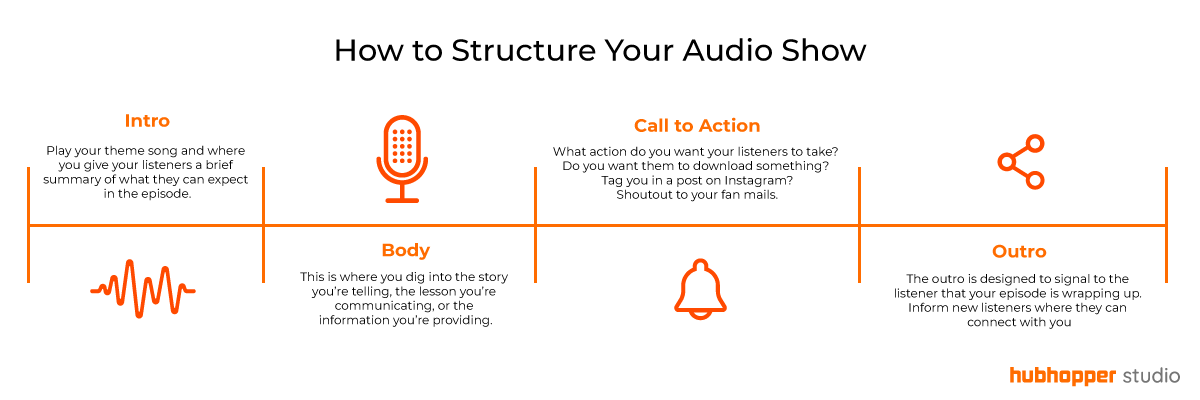
Mastering the Art of Podcast Scheduling
In any job, most of the magic happens when you show up regularly and on time. It is the same when you’re thinking of how to start a podcast.
Podcasting is no different. Before you start your podcast, a schedule helps you avoid any anxiety and keeps you focused on creating content consistently.
Everybody talks about consistency but for good reason. Consistently uploading episodes keeps your audience hooked and wanting more. With a podcast schedule you’re consistently putting out episodes and here are the benefits of following a podcast schedule:
- It streamlines your production and increases your efficiency. With a plan, everything falls into place.
- Releasing episodes at the right time and day can make or break your episode’s performance for the first 24 hours. Knowing when your audience is active and listening to your episodes can maximize listens.
- Your schedule becomes the North Star and keeps you on track.
Here is a blog that can help you create a schedule plan.
The Technical Aspect of Podcasting
When you’re thinking of how to start a podcast, understanding the technical aspect is key. Let’s dive into the technical side of things.
What is an RSS feed?
Understanding what an RSS feed is crucial when you’re figuring out how to start a podcast because it is the most basic technology your podcast hinges on. Here’s a very simple explanation.
Your favorite TV show is available on a channel or streaming platform. A podcast also needs a place where different podcast listening platforms can stream it on.
This place has all the information like the name, cover art, and the episodes. This place is the “RSS feed”.
Whenever you upload a new episode you upload information to your RSS feed that all the podcast directories read and make it available on their platform.
Podcasters typically don’t create the RSS feed manually, since the podcast hosting platform takes care of it. That’s where we – Hubhopper, a podcast hosting platform – come in and generate and manage your RSS feed for you.
Hosting Your Podcast – Simplified
Your podcast hosting platform not only creates your RSS feed but does so much more. If you host your podcast on Hubhopper, we make the process of creating podcasts simple and seamless for creators.
The in-built tools of the studio helps you in creating, editing, and uploading your episodes with ease.
We get your podcasts across both regional and global platforms through its extensive distribution network. Hubhopper’s set of amazing features help you create with ease.
Whether it is microsites, embedded players, private podcasts, or AI tools, we ensure that you focus on creating great content while our platform handles all the technical aspects.
Equipment
When people think of how to start a podcast, they think of expensive gear. You don’t need a big budget or fancy equipment to begin your podcasting adventure. In fact, you already have some powerful tools right at your fingertips.
Your trusty phone’s built-in microphone can be your best podcasting buddy, and with Hubhopper Audio Recorder and Editor, you have the magic wands you need.
Podcasting is all about affordability, so you don’t need a Hollywood setup or a superstar’s face to get started. We’ll share some great pro-tips to record clean audio with your phone’s microphone in the next section.
But if you’re ready to level up and sound even more professional, here are some recommendations:
Samson Q2U – It is a budget friendly microphone without compromising on quality. The USB and XLR connection gives you flexibility too. The sound quality is top notch and will boost your podcast’s production level.
Rode wireless microphone – If you’re recording with a video podcast where you don’t want bulky mics taking up space, this microphone is a good option.
The Blue Yeti – It is a USB microphone that’s widely known among podcasters and is frequently used by them. What sets them apart from other suggestions is its range of polar patterns. In simple words, it is great for a single person, or multi guest podcast.
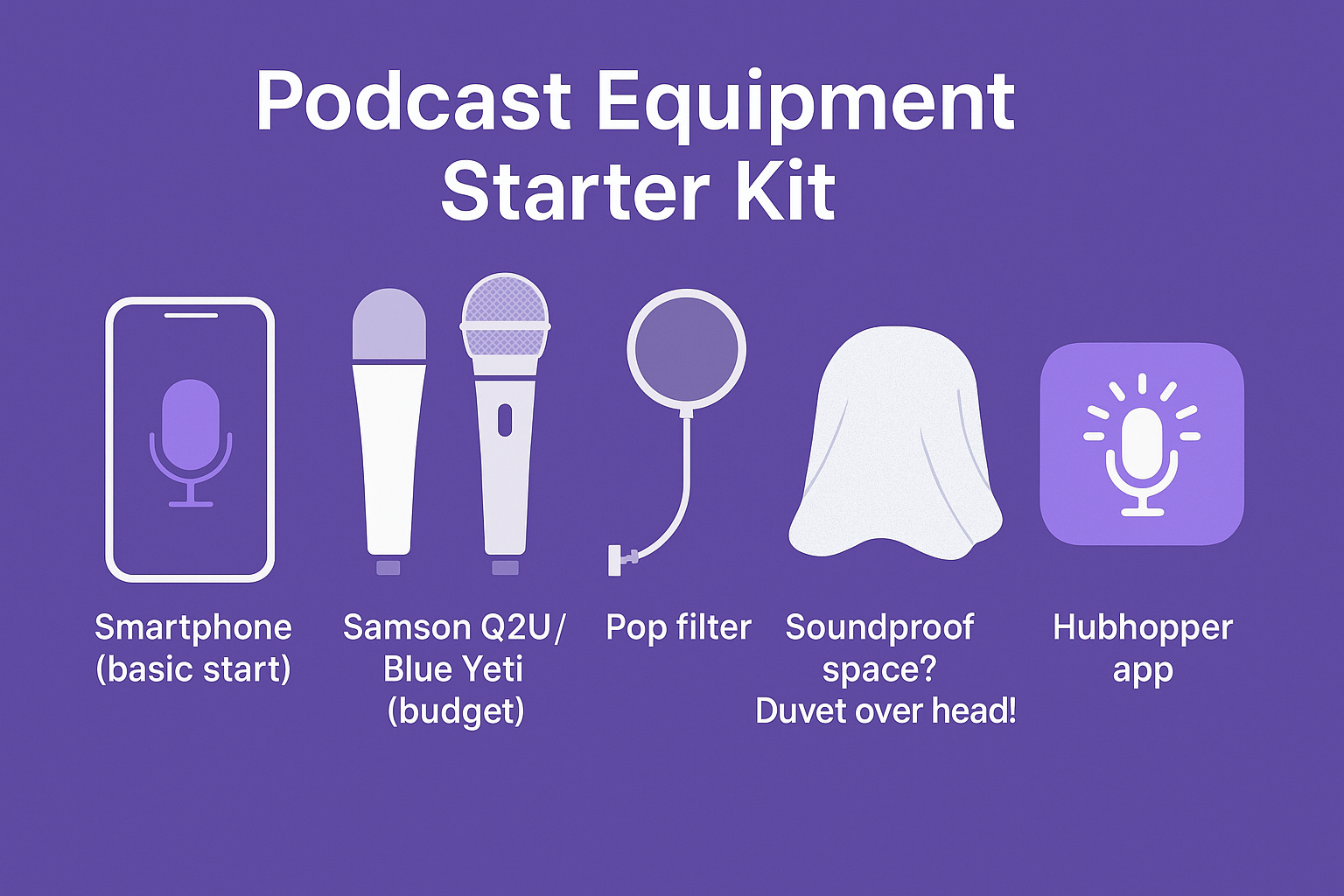
Recording Tips for Crystal-Clear Sound
Recording your podcast on the go is a breeze with our mobile app. To achieve that crisp and clean sound, follow this secret recipe:
1. Find a Quiet Spot: Seek out a peaceful corner and turn off fans and AC to minimize background noise.
2. Create Your Audio Sanctuary: Close the door to create a quiet space where your voice can shine.
3. Find the right time: If your surroundings have disturbances, record when it is whisper-quiet for high audio quality.
4. DIY Pop Filter: Don’t have the money to spend on a pop filter? Grab a sock that’s not too thick or too thin and cover your phone’s mic.
5. Cozy Sound Booth: Drape a cotton sheet over your head to create a makeshift sound booth that enhances your audio.
Despite all the precautions, background noise may sneak in. In that case, Adobe Podcast Enhance is a great option.
With a few clicks and minutes, your audio will be cleaned up and no one would even know that the audio has disturbances.
When you’re all set to record, you have two choices – having a podcast outline or a script. An outline is your key points in one place so you know what to talk about without going off topic or in circles.
A script is a word-to-word written form of what you want to say. See which one works better for you, just remember the episode should sound natural and conversational. Avoid being too robotic or monotonous.
Crafting and Editing Your Podcast with Ease
When it’s time to edit your podcast, remember that moderation is key. Trim excessively long pauses to maintain a smooth flow. Pauses can add flavor, but too many can be a buzzkill. Cut the clutter while keeping the essence.
Our trusty Hubhopper Audio Editor is your sidekick here. Use it to add background music, adjust volume, and make your podcast a delightful listening experience.
Remember when we talked about intro and outro? They create an auditory memory and give your show a professional touch. You record them once and then add them whenever you edit an episode. They’re the secret sauce of podcasting charm.
With these tips, you’ll be crafting and editing your podcast like a pro. The podcasting world is your oyster, so go forth and dazzle!
Hubhopper Studio Editor: Our simple yet powerful tool is here to assist you in editing your podcast. It can help you add music, apply fade in and out effects, and trim unnecessary parts from your audio. Sign up on Hubhopper Studio today to start your very own podcast.
For additional help with editing, check out our video tutorial that guides you through using the Hubhopper Studio Editor.
The built-in editing tools make podcast creation a smooth journey, and you can even eliminate any background noise that might sneak into your audio using the Audacity tool.
Scheduling
We’ve emphasized the significance of having a content schedule for your podcast. However, the question arises: how do you actually stick to that schedule without manually posting your podcast each day?
Here’s where Hubhopper’s built-in solution, episode scheduling, comes into play. When you sign up on Hubhopper, you gain access to this feature. It allows you to schedule your episodes in advance.
Instead of holding everything in your life to upload your episode at the right time, you can schedule it and relax. You can even batch schedule episodes for the month and focus on other important aspects of your creation process.
Launch
The fun part of how to start a podcast is here. Your podcast launch! Launch is where all your efforts start to come together. After you’ve crafted everything, you can now start your podcast, launch your first episode, and distribute your podcast.
If you’re looking for a podcast hosting platform, you can sign up for free on Hubhopper, and start your podcast. We’ve already discussed all the details you’ll need to start one, all that’s left is distributing your podcast.
Discoverability & Distribution
In the vast and ever-expanding world of podcasts, discoverability is a term that holds immense significance. It refers to the ease with which potential listeners can find and explore your podcast. Now, why is this so crucial, and how does global distribution play a pivotal role?
Why Discoverability Matters:
1. Stand Out in the Crowd: There are millions of podcasts out there, covering a myriad of topics. Ensuring your podcast is discoverable sets it apart from the noise and gives it a chance to shine.
2. Attracting New Listeners: Discoverability is the gateway to expanding your listener base. It’s how you bring in fresh ears, grow your audience, and establish a connection with a broader community.
3. Creating Impact: Whether you’re sharing knowledge, telling stories, or sparking discussions, your podcast is a vessel for making an impact. Discoverability amplifies your reach and influence.
4. Monetization: For those considering monetizing their podcasts, discoverability is a key factor. Advertisers and sponsors seek podcasts with a strong, easily discoverable presence.
The Role of Global Distribution:
Distributing your podcast on various global listening platforms is a game-changer in enhancing discoverability. Here’s why:
1. Global Reach: These platforms have a worldwide audience. By featuring your podcast on them, you unlock the potential to reach listeners from different corners of the globe.
2. Diverse Audiences: Different platforms attract various types of listeners. This diversity broadens your reach and helps you connect with audiences who resonate with your content.
3. Accessibility: Podcast listeners have their preferences when it comes to where they listen. Global distribution ensures your podcast is available on platforms they frequent, making it convenient for your audience.
Here is a list of platforms where your podcast will be distributed if you host your podcast with us:
- Hubhopper app and web
- Spotify
- Amazon Music
- TuneIn
- Gaana
- Pocketcasts and many more…
In a nutshell, discoverability is the compass guiding your podcast’s journey. To make your content accessible and relevant to a global audience, distributing on various listening platforms is indispensable. It’s not just about getting your podcast out there; it’s about making it accessible to anyone, anywhere.
Post Launch: What Comes Next
The final step of how to start a podcast is the post-launch. Once your podcast is launched and live for the world to hear, the journey is far from over. In fact, it’s just the beginning.
There are several crucial post-launch tasks to consider that can help you sustain and grow your podcast’s success. These include promoting your episodes, and monitoring performance.
Let’s delve into these post-launch strategies in more detail to ensure your podcast continues to thrive.
Marketing – The Path to Podcast Success: Proven Tactics
Your podcast has taken flight, and now it’s time to make it soar high in the podcasting sky. Here are some simple yet powerful strategies to catch your audience’s attention:
1. Reliability Rules: Consistency is your best friend. It will nurture your current audience and attract more listeners when they see that you’re an active podcaster. Prepare episodes in advance and schedule them for a seamless flow.
2. Perfect Timing: Release episodes when your audience is most likely to listen. Pick the right moment to captivate your fans. For example, horror podcasts perform well at night, while self-help podcasts perform well in the day – when people are commuting. Try to get in the shoes of your listener, and make an educated assumption about their podcast listening habits.
3. Collaboration is Key: Join forces with fellow podcasters in your niche. Collaborate, not compete, and watch your podcast grow.
4. Social Media Magic: Use social media to its full potential. Share teasers, interact with your audience, and create engaging content.
5. Mailing List Charm: Build an email list for a direct connection with your listeners. Share episode links and behind-the-scenes stories.
6. Create Your Digital Home: Craft a free micro-website using Hubhopper Studio to increase discoverability and improve your SEO.
7. Share the Love: Offer freebies related to your podcast theme to engage and gather leads.
8. Podcast Tour: Appear as a guest on other podcasts in your niche to promote your work and build awareness.
And for more podcasting wisdom, check out our blog on ‘15 Powerful Strategies to Promote Your Podcast.’ It’s packed with tips and tricks to supercharge your podcast’s success. Keep the magic alive!
Analytics
Analytics hold the key to understanding your audience better than ever. Dive into their listening patterns and watch your content creation plan flourish.
Data at Your Fingertips
Ever wondered which devices your listeners prefer? Explore the world of operating systems to see if they’re Team iPhone, Android, or even something more unique. It’s like a tech safari for your ears!
Discover the hottest podcast platforms for your show with our Podcast Player data. Is it Gaana, Spotify, or Apple Podcasts? Keep an eye on trends and choose the apps that elevate your podcast.
Download Your Insights
Hubhopper Pro offers advanced analytics, and you can even download this data in CSV format from your analytics dashboard. It’s like getting a backstage pass to your podcast’s performance!
Explore Device Preferences
Wondering which gadgets your listeners love? From generic smartphones to Apple Watches, our device distribution data has you covered. Get a peek into your audience’s tech preferences.
Time Travel with Custom Date Range
Break free from time constraints and view data beyond 90 days. Choose your custom date range and explore the insights that matter most to you. It’s like having a time machine for your podcast analytics!
So, embark on this data adventure and use these insights to empower your podcast, making it the best it can be. Your journey to podcast greatness continues!
How to start a podcast on YouTube?
To start a podcast on YouTube, you’ll need a Gmail ID. Once you’re signed in, follow these steps to start a podcast on YouTube.
Step-by-step guide on how to create a podcast on YouTube
Step1: Go to YouTube, and click on your profile image at the top right. Click on “Create a channel”
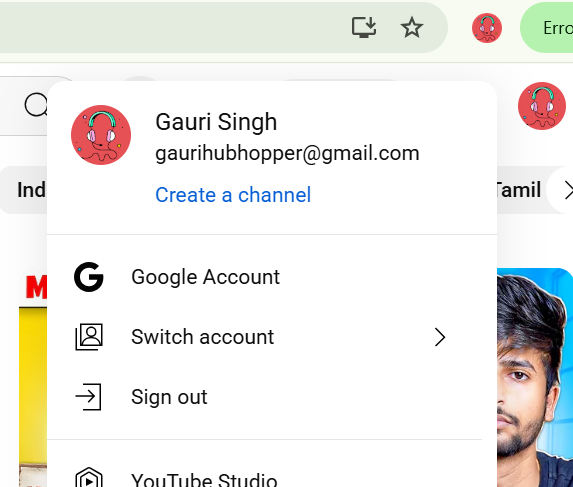
Step 2: A pop up will appear, where you can edit your name and handle. You can make any changes you want, and click on Create Channel.

Step 3: Once your channel has been created, click on your profile at the top right again, and go to YouTube Studio.
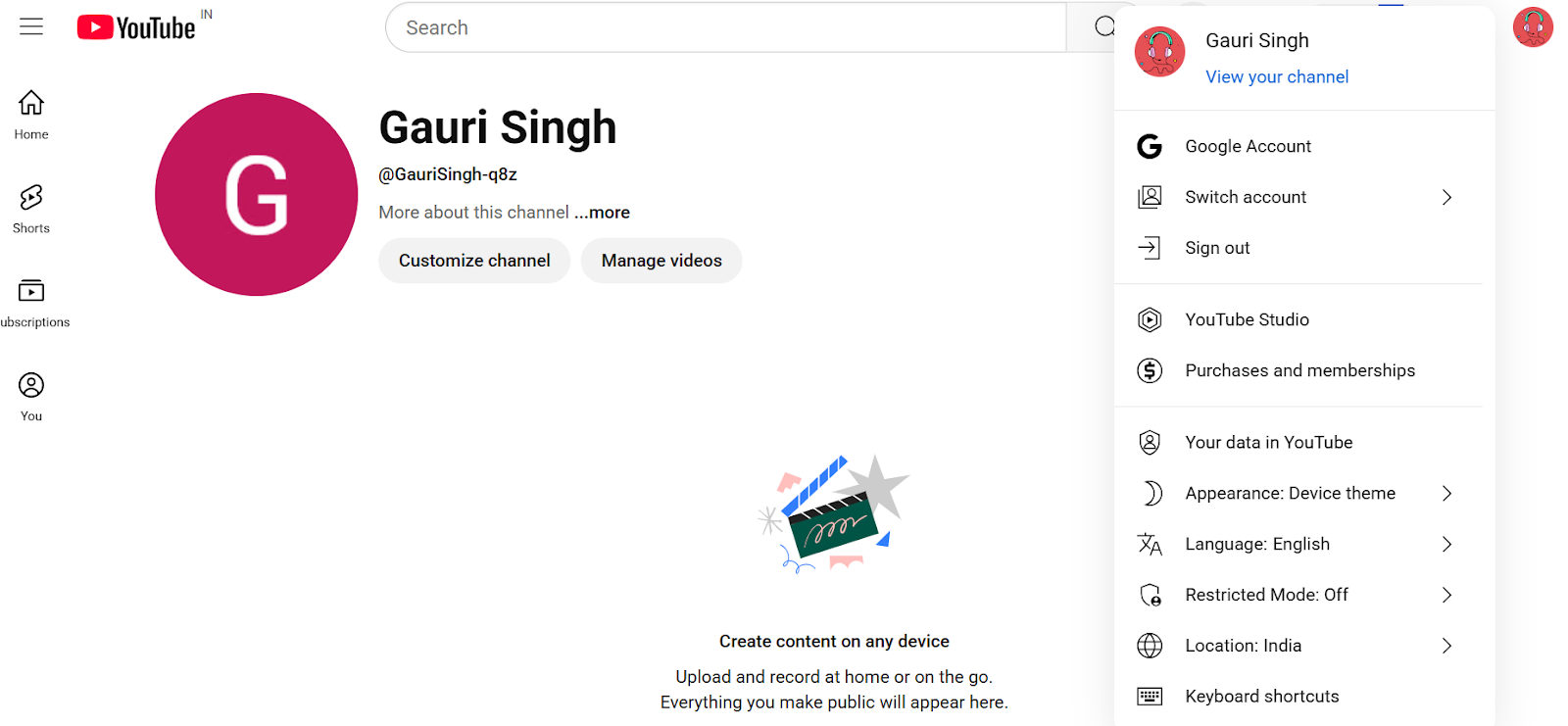
Step 4: In YouTube Studio, click on Create and upload a video first, without an existing video you cannot create a podcast. Once you’ve uploaded a video, click on New Podcast
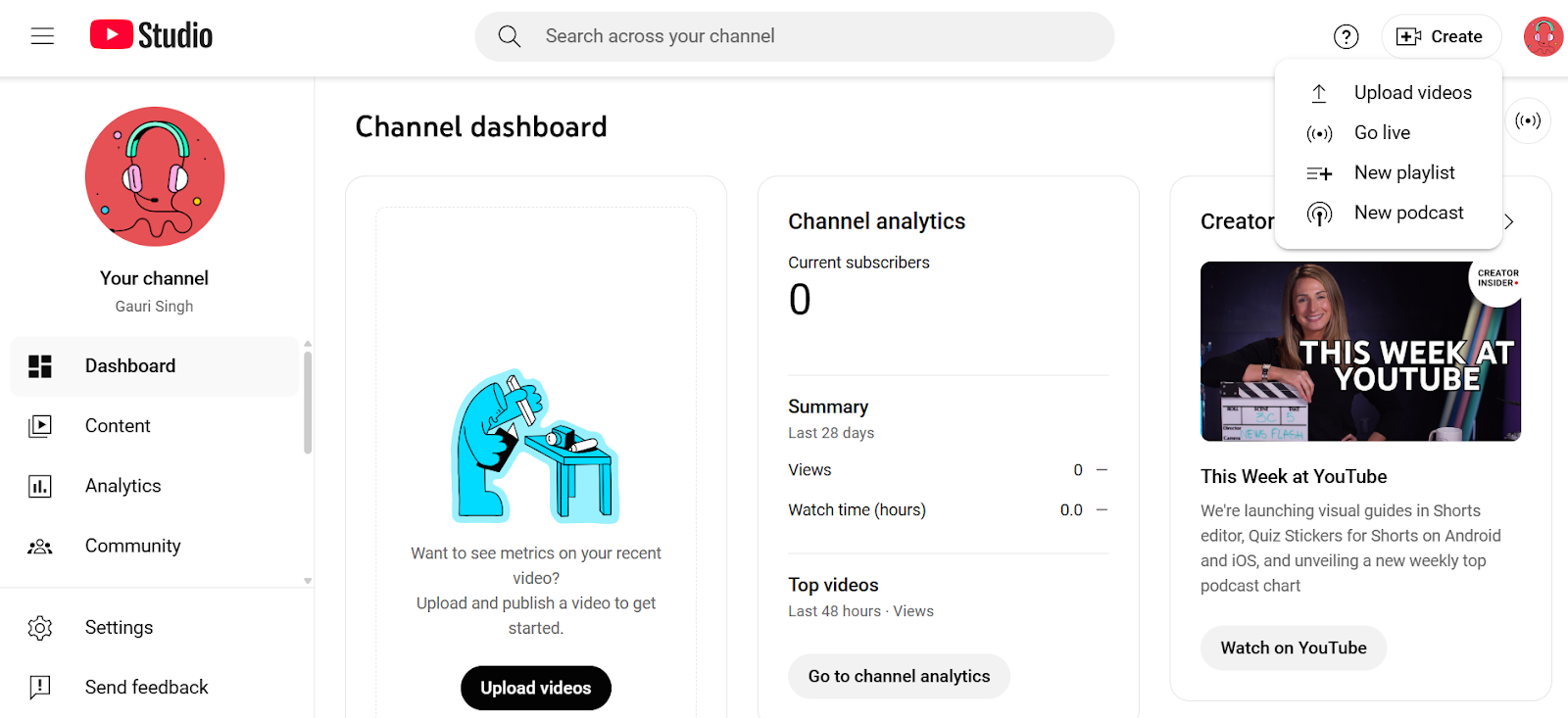
Step 5: You can submit your existing RSS feed or Create a New Podcast. Submitting your RSS feed will make your existing episodes live on YouTube.
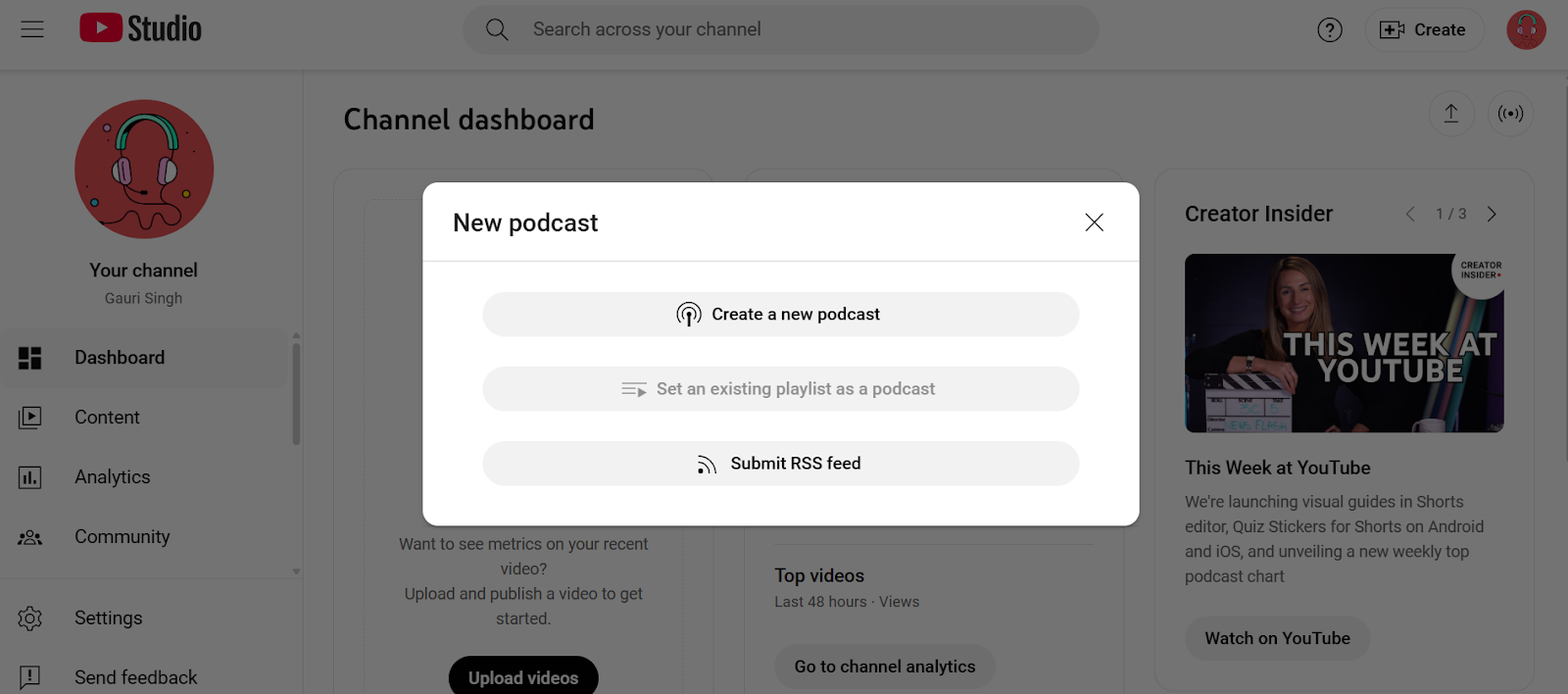
Step 6: If you’re creating a new podcast, YouTube will ask you the podcast name and description. Add that and the video you uploaded. Your podcast is ready!
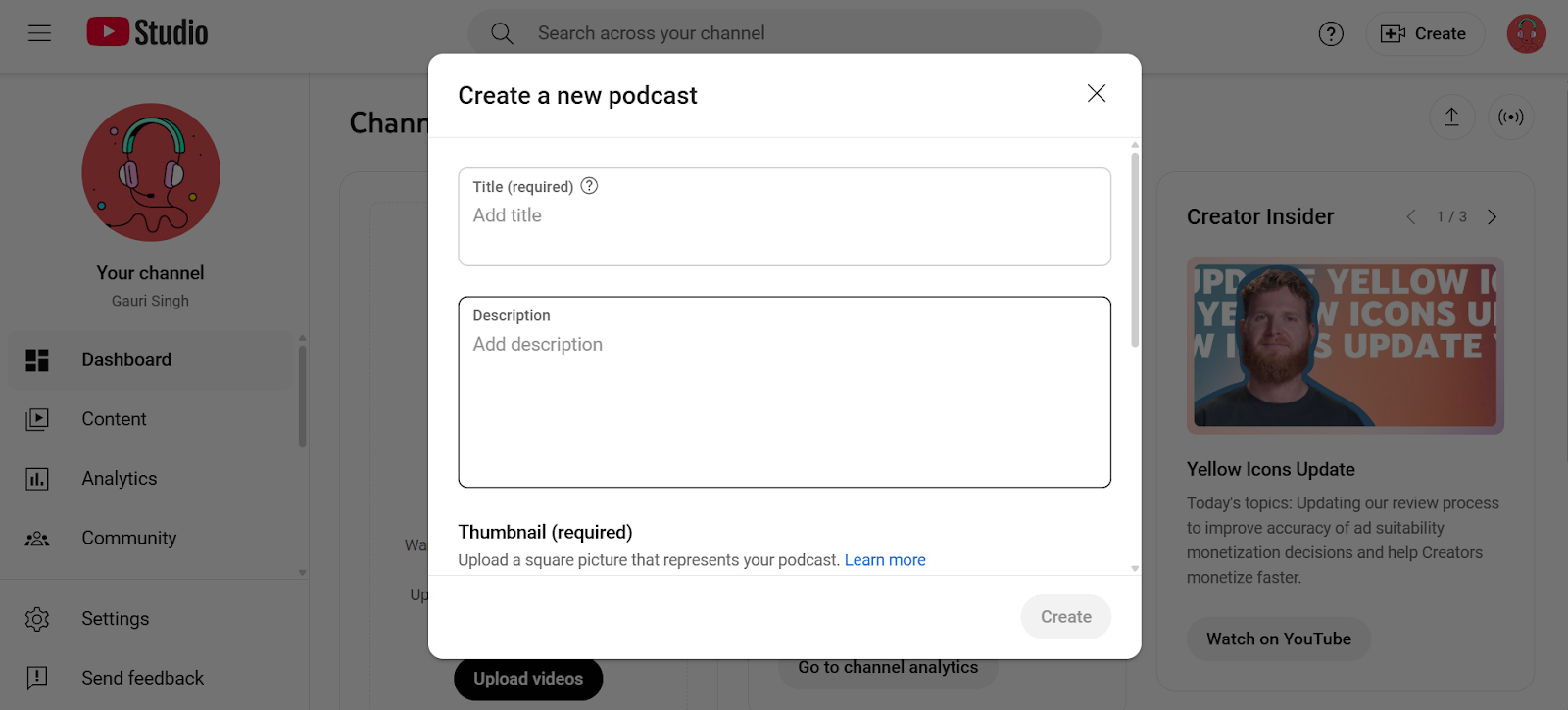
When it comes to starting a podcast on YouTube, you can follow the above steps to plan your podcast. For the video aspect of your podcast, there are three ways you can approach:
Use your podcast cover art
You can turn your audio podcast into a simple video by adding your podcast cover art as the visual. It’s a low-effort way to publish your podcast on YouTube.
However, keep in mind that this format may not fully engage viewers, as most people on YouTube expect to see an actual video of the podcast when searching for video content.
Record yourself
You can film yourself while recording your podcast. It is the most common type of video podcast and has benefits over just an audio podcast. The viewer is able to see your expressions, and body language which humanizes you. You can also add any visuals or images within the video to better represent what you are talking about.
Apart from the mic, you’ll need a camera to shoot your video. As a beginner, you can use your smartphone to record yourself.
Use AI
You can use AI generated videos or clips to your audio podcast. It is better than having just your podcast cover art and when done right can be just as engaging as a conventional video podcast. It is also ideal for people who are camera shy.
You can use AI tools like Sora, and Midjourney to create the videos and images. Ensure that you specify that the video uses AI elements when you’re uploading your episode on YouTube.
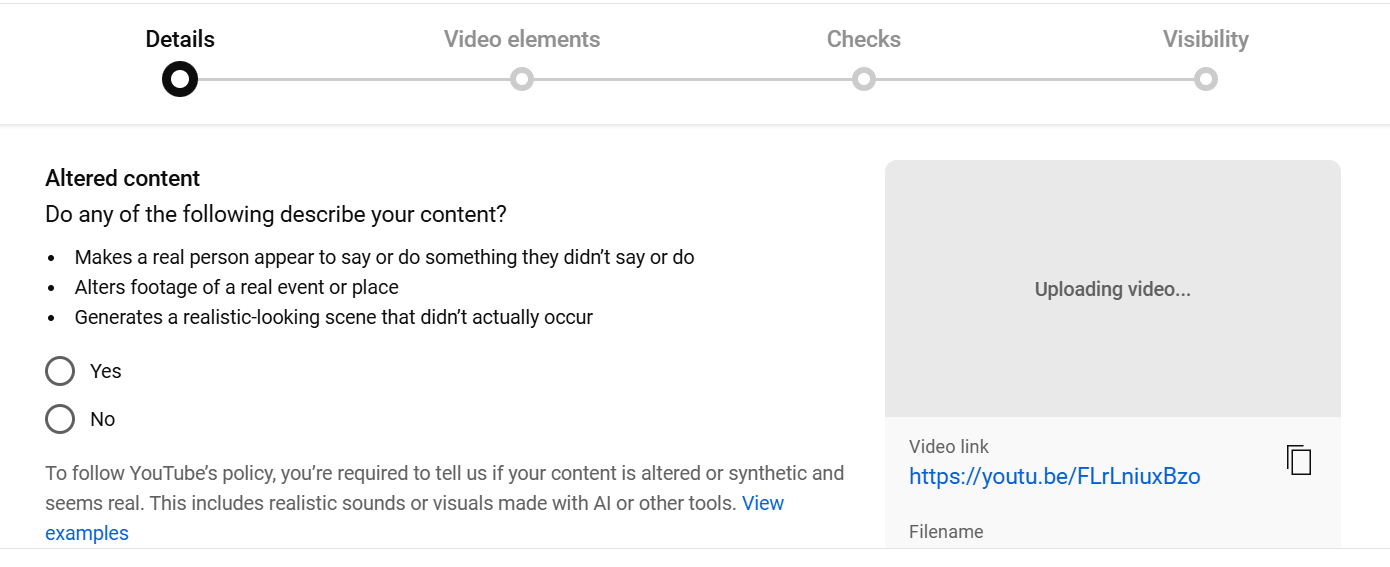
How to start a podcast on Spotify?
You can start a podcast on Spotify by either using Spotify for Creators as your podcast host. The process of planning, recording, and launching your podcast remains the same as detailed in the blog.
You can use podcast hosting platforms like Hubhopper as well to start a podcast on Spotify. Hubhopper will not only distribute your podcast to Spotify but other podcast hosts too like Apple Podcasts, Amazon Prime and more.
If you want to know how Spotify for Creators and Hubhopper compare, you can read a full breakdown on the features in this blog.
How to start a podcast – The Checklist
So, now that you’ve gone through the entire blog and have a strong foundation on how to go about it. But all these steps can be pretty overwhelming. We’re going to give you a FREE checklist that will set you up for success and you’ll not be worried about missing anything. Just click here and you’ll be directed to a Notion Checklist.
Here’s what you do next
Once you get the checklist, you start actually working on each task and keep ticking them off, so you feel that you’re accomplishing something.
I get that it feels overwhelming to start a podcast, but with the checklist and this comprehensive but concise guide, you now have a broken down step-by-step process of going about making your podcast.
You’re actually way closer to making your podcast than you think right now. You just need to take the leap of faith and put in the work, and you’ll be good to go. We believe in you and always have your back.
I can’t wait to see what you come up with! Happy Podcasting.
Frequently Asked Questions (FAQs)
How do I start a podcast?
To start a podcast, all you need is a podcast topic, and a podcast hosting platform to distribute it. You can brainstorm ideas, write your podcast outline or script, record your episode, and upload it onto your podcast hosting platform of your choice and you’re done. For a detailed guide on how to be consistent and market your podcast, read the blog.
How to start a podcast on YouTube?
To start a podcast on YouTube, you need to create a channel, upload a video, and then create a podcast or convert an existing playlist into a podcast. You can also submit your RSS feed and your existing episodes will be available on YouTube.
How to start a podcast on Spotify?
To start a podcast on Spotify, you can either opt for Spotify’s podcast hosting platform, or use any other podcast hosting platform like Hubhopper to create a podcast. Hubhopper will automatically distribute your podcast to Spotify.
How to start a podcast for free?
To start a podcast for free, you can start with what you have – your smartphone to record your episode and a free podcast hosting platform. To plan and market your podcast, you can use your laptop.

